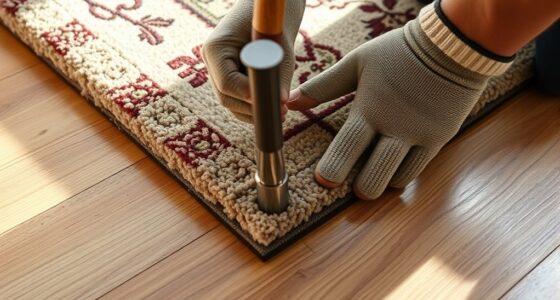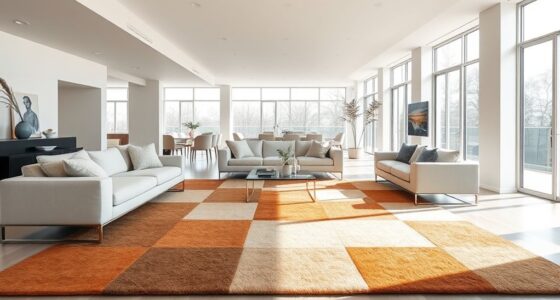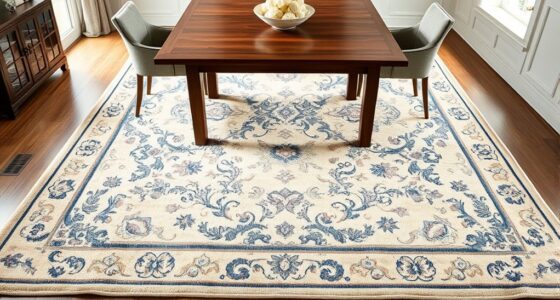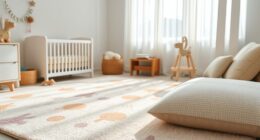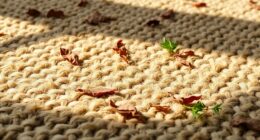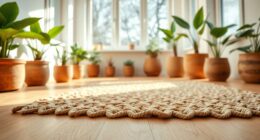When choosing a neutral rug for an art-heavy room, focus on subtle colors like beige, gray, or taupe to create a balanced backdrop that highlights your artwork. Opt for textures and materials that add depth while remaining durable enough for everyday use. Select a size and placement that anchors your art displays without overwhelming the space. By balancing pattern, color, and layering, you’ll achieve harmony—learn more tips to perfect your design.
Key Takeaways
- Select neutral tones like beige, gray, or taupe that subtly contrast with walls and furniture to highlight artwork without distraction.
- Opt for durable materials such as wool or synthetic fibers to withstand daily wear while maintaining a refined look.
- Choose appropriately sized rugs that anchor key art pieces and create balanced visual flow within the room.
- Incorporate layered textures and subtle patterns to add depth without competing with the artwork’s visual impact.
- Use warm, soft lighting to enhance the neutral rug’s background, emphasizing art and creating a cohesive, inviting atmosphere.
Understanding the Role of Neutral Rugs in Art-Heavy Spaces

In art-heavy spaces, neutral rugs serve as a subtle foundation that allows your artwork to stand out. They create a balanced backdrop, ensuring your vibrant or intricate pieces aren’t overwhelmed. By choosing a rug with harmonious, neutral tones, you establish a cohesive color harmony that complements your artwork without competing with it. This approach highlights your artistic focal points, drawing attention to your favorite pieces rather than distracting from them. Neutral rugs act as a visual anchor, grounding the room’s design while maintaining flexibility to showcase various art styles. They help you craft a sophisticated, curated look where your artwork remains the star. Ultimately, a well-chosen neutral rug enhances the overall aesthetic without overpowering the artistic expressions on display.
Selecting the Right Color Palette for Your Rug

Choosing the right color palette for your rug begins with understanding the overall mood and style you want to create. Focus on color harmony to guarantee your rug complements your art and existing decor. Neutral tones like beige, gray, or taupe often serve as versatile backdrops, providing visual cohesion without overpowering your artwork. If you prefer a subtle contrast, select shades that subtly differ from your wall colors or furniture. Keep in mind that a cohesive palette ties the room together, making art pieces stand out naturally. Avoid overly busy patterns or bold colors that could clash or distract. Ultimately, your goal is to choose a palette that supports the art’s prominence while adding subtle warmth or depth to your space. Incorporating color harmony principles can further enhance the visual balance in your room, especially considering how air quality and environmental impacts can influence the overall ambiance and longevity of your decor choices. Additionally, selecting dyes and materials that are environmentally sustainable can help improve indoor air quality and contribute to a healthier living environment. Being mindful of personal comfort and sensory preferences also ensures your space remains inviting and harmonious. Incorporating natural light into your design can also illuminate your art and complement your chosen color palette effectively.
Texture and Material Considerations for Visual Balance

To create visual balance, you should consider how different textures contrast and complement each other in your space. Think about the durability of materials to guarantee your rug withstands daily use without sacrificing style. Balancing visual weight with the right textures and materials helps your room feel cohesive and inviting. Incorporating appropriate spray tips ensures a smooth finish and enhances the overall appearance of your painted surfaces. Additionally, being aware of store hours can help you plan your shopping for rug materials efficiently.
Textural Contrast Strategies
Creating visual interest with neutral rugs involves carefully balancing textures and materials. To achieve this, focus on fiber density and pile height. Rugs with high fiber density feel plush and dense, adding richness and a tactile contrast against smoother surfaces. Conversely, a rug with a low pile height offers a sleek, streamlined look that balances softer textures in the room. Combining different pile heights creates visual layers that highlight the art without overwhelming it. For example, pairing a tightly woven, low-pile rug with a shaggy, high-pile piece introduces variation that draws the eye. Fiber density also influences how the rug interacts with light and sound, adding depth to the room’s overall aesthetic. Additionally, incorporating elements from sound healing science can enhance the sensory experience of the space. Understanding how sound absorption properties of different materials affect acoustics allows for more intentional design choices. Considering clutter reduction strategies can help maintain the visual clarity and focus on the art, ensuring the space remains balanced and harmonious. Incorporating soundproofing techniques can further improve the room’s acoustic environment, making it more comfortable for both viewing and listening. Thoughtful selection of materials can also improve the acoustic environment, making the room more comfortable for both viewing and listening. Use these elements intentionally to craft a harmonious, balanced environment.
Material Durability Factors
Material durability substantially impacts the visual balance of neutral rugs, especially when considering texture and material choices. Synthetic fibers, like nylon or polyester, offer durability and resistance to stains, making them ideal for high-traffic art-heavy rooms. They often have a softer appearance and can mimic natural fibers, providing a sleek, modern look. Natural fibers, such as wool, jute, or sisal, bring strength and longevity while adding organic textures that enhance subtle visual interest. However, they may require more care and can be less resistant to moisture or wear over time. When selecting a neutral rug, weigh the environment’s demands against these material properties. Choosing resilient fibers ensures your rug maintains its aesthetic appeal while standing up to daily use without compromising the room’s visual harmony. Additionally, understanding self-watering plant pots can inform choices about moisture management and material resilience in various environments.
Visual Weight Balance
Balancing visual weight in neutral rugs involves carefully considering texture and material choices to achieve harmony within your space. Texture influences how your rug interacts with art and furniture, creating a sense of balance or contrast. Material selection also impacts color psychology and cultural symbolism, affecting the room’s overall feel. To enhance visual balance, consider:
- Using plush textures to add softness and warmth
- Incorporating natural fibers like jute or sisal for grounding effects
- Choosing matte finishes to reduce visual heaviness
- Playing with subtle patterns for visual interest without overwhelming
- Considering cultural symbolism in patterns or materials for deeper meaning
- Paying attention to rug construction details to ensure durability and proper integration into your design
These choices help distribute visual weight evenly, ensuring your art remains the focal point while the rug complements the overall aesthetic.
Size and Placement to Enhance Artistic Displays

Choosing the right size and placement of neutral rugs can considerably enhance your artistic displays by drawing attention to key elements without overwhelming the space. Make certain the rug is large enough to frame your artwork or furniture, creating a cohesive visual flow. Proper placement, like positioning the rug so that it anchors the main art pieces, emphasizes color harmony and unifies the room. Consider fabric texture; a soft, plush rug can add warmth and subtle contrast to smooth, sleek artwork, while a textured weave can highlight the tactile qualities of your art. Avoid small or misplaced rugs that fragment the space or compete with your art. Instead, select a size and position that complements your displays, guiding the eye smoothly across your artistic arrangement. Additionally, spiritual significance of colors and textures can influence the mood and perception of the space, enhancing the overall aesthetic experience.
Coordinating Patterns and Solids for a Cohesive Look

Pairing patterns with solid neutral rugs creates a harmonious backdrop that highlights your artwork and furniture. When practicing pattern mixing, keep your color coordination simple by sticking to a neutral palette, allowing your art to stand out. To achieve a cohesive look, consider these tips:
- Mix subtle patterns with bold solids for visual interest
- Use a consistent color scheme across patterns and solids
- Vary pattern sizes for depth without overwhelming the space
- Balance busy patterns with calm, solid rugs
- Stick to neutral tones to keep the focus on your art
- Incorporate rustic textiles such as linen or cotton to add warmth and texture to your decor
- Incorporating AI-powered design tools can help visualize different pattern and color combinations for a more tailored decor scheme.
- Carefully selecting antique pieces that complement your rugs can introduce unique character and enhance the overall aesthetic.
Lighting’s Impact on Neutral Rug Appearance and Art Highlighting

Lighting plays a crucial role in how your neutral rug appears and how effectively your artwork is showcased. Different lighting effects can enhance or diminish the visual impact of your art and rug, influencing the room’s overall ambiance. Proper lighting emphasizes artistic focal points, making details pop and textures more noticeable. Consider warm lighting for a cozy feel or cool lighting for a modern look. Adjustable fixtures give you control over shadows and highlights, creating depth. Here’s a quick guide:
| Lighting Type | Effect on Art & Rug |
|---|---|
| Warm, soft light | Enhances warmth, highlights textures |
| Bright, neutral | Clarifies details, emphasizes colors |
| Directional spotlights | Draws attention to specific art pieces |
| Dim lighting | Creates mood, subtle background glow |
Choose lighting thoughtfully to maximize your art’s visual impact.
Layering Rugs for Depth and Dimension

Layering rugs instantly adds depth and dimension to your space, transforming a flat surface into a layered visual experience. To achieve this, start with a neutral base rug and add a smaller, textured rug on top. Incorporate decorative fringe for an elegant touch that catches the eye. Use rug padding beneath each layer to prevent slipping and protect your floors. Consider mixing different textures and pile heights to create contrast and interest. Keep the color palette neutral to maintain harmony with your art pieces. Layering also helps define seating areas and adds cozy appeal. Remember, the right combination of rugs can make your art-heavy room feel more inviting and dynamic without overwhelming the space.
Maintaining a Neutral Palette Amidst Vibrant Art Pieces

How can you keep a neutral palette intact when your art pieces burst with vibrant colors? Focus on color psychology; neutral rugs act as a calming backdrop that balances energetic artworks. They prevent the room from feeling overwhelming while allowing the art to be the focal point. Additionally, consider cultural symbolism—choosing neutral tones inspired by natural elements or traditional motifs can add depth without competing with vibrant pieces. By maintaining a subtle, understated base, you create harmony between the art and surroundings. This approach enhances visual coherence and ensures your room feels curated rather than chaotic. Ultimately, selecting neutral rugs rooted in thoughtful color psychology and cultural symbolism helps preserve a balanced, sophisticated aesthetic amid a lively display of art.
Tips for Incorporating Neutral Rugs in Modern and Traditional Styles

Whether you’re designing a modern or traditional space, incorporating neutral rugs can seamlessly unify your decor. To do this effectively, consider color theory—selecting shades that complement your existing art and furniture. For modern styles, opt for muted tones with subtle textures; for traditional looks, richer neutrals work well. Pay attention to cultural symbolism, as certain neutral hues carry specific meanings that can enhance your room’s story. Here are some tips:
- Use warm neutrals like beige or taupe to create inviting atmospheres
- Experiment with cool grays for a sleek, contemporary vibe
- Incorporate textured rugs to add depth without overwhelming art
- Match rug undertones with key accents for harmony
- Consider cultural symbolism when choosing colors to evoke specific feelings or themes
This approach ensures your neutral rug elevates both modern and traditional decor while respecting the room’s visual language.
Care and Maintenance Tips to Keep Your Rug and Art Focal Points Pristine

Maintaining the pristine condition of your neutral rug and art focal points requires regular care and mindful practices. Use vacuuming with a gentle setting to prevent dirt buildup, especially on eco-friendly fibers that resist harsh chemicals. Spot clean spills immediately with a mild, eco-conscious cleaner to avoid staining. When selecting rugs, consider custom dyeing options, which allow you to choose dyes that are both vibrant and sustainable, helping your rug stay looking fresh longer. Rotate your rug periodically to prevent uneven wear and protect your art from fading due to sunlight exposure. Avoid harsh cleaning products that can damage eco-friendly fibers or fade your artwork. By following these tips, you’ll preserve your neutral rug’s elegance and keep your art as stunning as the day you displayed it.
Frequently Asked Questions
How Do Neutral Rugs Influence the Overall Room Ambiance?
Neutral rugs influence your room’s ambiance by creating a balanced foundation that highlights your art and décor. They promote color harmony, allowing bold or vibrant pieces to stand out without clashing. Additionally, neutral tones can enhance the mood by making the space feel calm, inviting, and sophisticated. By choosing the right neutral rug, you subtly guide the overall atmosphere, ensuring your art remains the focal point while maintaining visual harmony.
Can Neutral Rugs Complement Both Modern and Traditional Art Styles?
Neutral rugs naturally nurture a nuanced, non-intrusive backdrop, seamlessly supporting both modern and traditional art styles. You’ll find that their subtle shades foster color harmony, while their tactile textures balance visual weight. This balance allows vibrant or intricate artworks to shine without distraction, creating a cohesive, calming atmosphere. Fundamentally, neutral rugs cleverly complement diverse art styles by providing the perfect foundation for visual variety and artistic expression.
What Are the Best Cleaning Methods for Maintaining Neutral Rugs With Art Displays?
To maintain your neutral rugs with art displays, focus on regular vacuuming using gentle techniques to avoid damaging artwork. For stain removal, act quickly with mild cleaning solutions suited for your rug’s material. Avoid harsh chemicals and abrasive scrubbing. By staying consistent with these methods, you protect both the rug and your art, ensuring everything stays fresh and vibrant over time.
How Do I Choose a Neutral Rug That Won’T Overshadow Vibrant Artwork?
Did you know that 85% of interior designers prefer neutral rugs because they create balanced spaces? When selecting a neutral rug, focus on color harmony by choosing shades that complement your artwork without competing. Incorporate texture contrast to add visual interest without overshadowing vibrant pieces. A subtle, yet textured rug can unify your room, allowing your art to shine while maintaining a serene, cohesive look.
Are There Specific Patterns or Textures That Work Best With Art-Heavy Rooms?
In art-heavy rooms, you want patterns and textures that complement your artwork without competing. Geometric patterns work well because they add visual interest while maintaining a modern, clean look. Plush textures create a cozy, inviting feel without overpowering vibrant pieces. You should choose rugs with subtle patterns or soft textures that enhance your artwork’s colors and details, letting your art shine without distraction.
Conclusion
So, go ahead and choose that neutral rug—you know, the one that won’t steal the spotlight from your art. After all, who needs a focal point when your walls are bursting with color? Just remember, the right rug can quietly tie everything together, leaving your art to shine without competition. Ironically, sometimes the best way to highlight vibrant pieces is with something so understated, it nearly disappears. Happy decorating!


